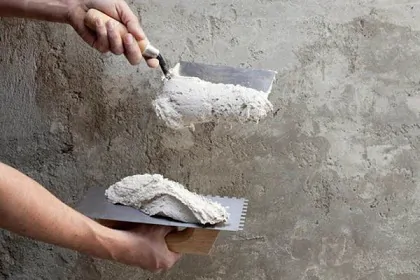
Interior Stucco Walls: Benefits, Styles, and Design Inspiration
Interior stucco walls provide a unique blend of aesthetic appeal, durability, and versatility that can transform your home. With moisture resistance and various finishes—from smooth
Are you in need of stucco repair services in Santa Fe, NM? Look no further! Our team of experts is here to provide you with top-notch restucco services to refresh and enhance the exterior of your home or business. Call us today!

Re-stucco and stucco repairs are available to help your building get a new life and restoration. Stucco has a tendency to crack or flake off of exteriors, often as a result of temperature changes, excessive or severe weather, as well as other factors including stucco that has not been mixed properly. When this occurs, your stucco will likely stick for a little while but you will notice it deteriorating quicker than usual.
If you’re wondering whether or not it is possible to re-stucco or apply a new layer of stucco over an old layer of stucco, then the answer would be yes! However, the new layer of stucco is only as secure and durable as the old layer that it’s being applied on. If your old layer of stucco is cracked and severely uneven, then you can expect your new layer of stucco to crack in the same or similar area as your old one. It is best to start out a new layer of stucco over an even or refined old layer, to ensure lasting results.
Stucco repairs might be needed when your stucco has significant chips or cracks in its surface. As mentioned previously, this can happen when your stucco is aging, hasn’t been applied or mixed well, and could simply use some revamping. Stucco repairs are typically done using another enhanced stucco composite that binds together and seals any cracks or crevices that have since formed in the original structure. Stucco patching solutions are also available for minor layers of cracked stucco that don’t necessarily need filling but rather resurfacing.
Cleaning your stucco also requires some patience as well. Taking on the challenge of cleaning stucco isn’t an easy one, given that the material is quite porous and can easily accumulate all kinds of dirt, dust, and debris over time. And while your stucco doesn’t necessarily need to be cleaned once a month, you should consider having a professional cleaning done to it ever so often to maintain its original appearance and prevent discoloration. Professional stucco cleaners are able to safely remove large amounts of debris from your stucco without damaging it or scrubbing away its texture. If you need at-home tips to remove minor scuffs or dirt, you can also use a dampened nylon cloth to do minor touch-ups.
Other general maintenance that’s needed on stucco, aside from cleaning and repairs, includes inspections. While you may not be able to repair the stucco by yourself, you can certainly track when it’s starting to deteriorate and notify a professional about the damages before they worsen. Doing so will also save you significant time and cost on re-stucco projects, if your existing stucco isn’t too old or in poor condition. However, if you notice your stucco deteriorating, cracking or flaking, you’ll be happy to know that the repairs are easy and can be done in a jiffy to prolong your stucco’s appearance and lifespan.
Common signs that stucco needs repair include cracks, bulging, discoloration, and chipping. If you notice water stains, mold growth, or peeling paint near stucco areas, moisture may be trapped beneath the surface. Soft or crumbling stucco is another red flag indicating structural weakness. Regular inspections help identify small issues before they escalate into costly repairs, ensuring your home remains well-protected.
Stucco cracks due to various factors, including foundation settling, temperature fluctuations, and improper installation. As the structure expands and contracts with weather changes, stucco may develop hairline cracks. Water damage, poor drainage, and impact damage can also contribute to larger cracks. Identifying the cause of the cracking is essential for effective repairs and long-term durability.
The duration of stucco repair depends on the size and complexity of the damage. Small patch repairs can be completed within a few hours, while larger repairs or resurfacing projects may take several days. Drying time for stucco patches and finishing coats also affects the total repair time. Professional stucco contractors can provide a more accurate timeline based on your specific repair needs.
Yes, stucco repair typically requires tools such as a trowel, putty knife, hawk, wire brush, and mixing tools. For larger repairs, a power mixer and stucco sprayer may be needed. Professionals use specialized materials, including bonding agents and waterproofing sealants, to ensure long-lasting results. Proper application techniques and tools are crucial for a seamless finish.
Blending stucco repairs with the existing texture and color can be challenging. A skilled contractor can match textures by using the right application techniques and tools. However, color matching is more difficult because stucco can fade over time. In some cases, repainting or reapplying a color coat to the entire wall is necessary to achieve uniformity.
Proper stucco repair can help prevent future damage by sealing cracks and preventing moisture infiltration. However, if underlying issues such as poor drainage or structural settling are not addressed, new damage may occur. Regular maintenance and inspections can extend the life of your stucco and reduce the need for frequent repairs.
Spring and fall are typically the best seasons for stucco repair, as moderate temperatures and low humidity provide optimal drying conditions. Extreme heat or cold can affect how stucco cures, leading to potential cracks or poor adhesion. If repairs are urgent, professional contractors can use special additives to work in less-than-ideal weather conditions.
Yes, stucco repair can address minor water damage, but if moisture has penetrated deeply, a more extensive repair may be required. Water-damaged stucco often needs to be removed and replaced to prevent mold growth and structural issues. Identifying and fixing the source of the moisture, such as faulty flashing or poor drainage, is essential to prevent recurring damage.
To maintain stucco after repairs, regularly inspect for new cracks, clean the surface with mild detergent and water, and ensure proper drainage around your home. Applying a high-quality sealant or waterproof coating can help protect stucco from moisture infiltration. If repainting is necessary, use a breathable, elastomeric paint designed for stucco surfaces.

Interior stucco walls provide a unique blend of aesthetic appeal, durability, and versatility that can transform your home. With moisture resistance and various finishes—from smooth

Walls do more than divide rooms; they set the mood and style of your home. If you are looking for a way to add depth,

When it comes to home improvement projects, drywall installation is a common task that often raises questions about costs. Whether you are building a new
Stucco Contractors Santa Fe has been serving the Santa Fe area with quality stucco and plastering services for many years and continues to do so with the same standard of service that we always have.
© 2025 Stucco Contractors Santa Fe NM All rights reserved